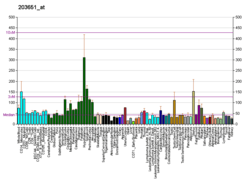ZFYVE16
Zinc finger FYVE domain-containing protein 16 is a protein that in humans is encoded by the ZFYVE16 gene.[4][5]
The ZFYVE16 gene encodes endofin, an endosomal protein implicated in regulating membrane trafficking. It is characterized by the presence of a phosphatidylinositol 3-phosphate-binding FYVE domain positioned in the middle of the molecule (Seet et al., 2004).[supplied by OMIM][5]
In melanocytic cells ZFYVE16 gene expression may be regulated by MITF.[6]
Interactions
ZFYVE16 has been shown to interact with TOM1.[7]
gollark: I try to not mistreat my dragons, thank you.
gollark: *continues preferring silvers*
gollark: I've already collected most of the dragons I like, so I've got basically no clue what to do.
gollark: To the hub!
gollark: It is called boycotting, yes.
References
- GRCh38: Ensembl release 89: ENSG00000039319 - Ensembl, May 2017
- "Human PubMed Reference:". National Center for Biotechnology Information, U.S. National Library of Medicine.
- "Mouse PubMed Reference:". National Center for Biotechnology Information, U.S. National Library of Medicine.
- Seet LF, Hong W (November 2001). "Endofin, an endosomal FYVE domain protein". The Journal of Biological Chemistry. 276 (45): 42445–54. doi:10.1074/jbc.M105917200. PMID 11546807.
- "Entrez Gene: ZFYVE16 zinc finger, FYVE domain containing 16".
- Hoek KS, Schlegel NC, Eichhoff OM, Widmer DS, Praetorius C, Einarsson SO, et al. (December 2008). "Novel MITF targets identified using a two-step DNA microarray strategy". Pigment Cell & Melanoma Research. 21 (6): 665–76. doi:10.1111/j.1755-148X.2008.00505.x. PMID 19067971.
- Seet LF, Liu N, Hanson BJ, Hong W (February 2004). "Endofin recruits TOM1 to endosomes". The Journal of Biological Chemistry. 279 (6): 4670–9. doi:10.1074/jbc.M311228200. PMID 14613930.
Further reading
- Nagase T, Ishikawa K, Nakajima D, Ohira M, Seki N, Miyajima N, et al. (April 1997). "Prediction of the coding sequences of unidentified human genes. VII. The complete sequences of 100 new cDNA clones from brain which can code for large proteins in vitro". DNA Research. 4 (2): 141–50. doi:10.1093/dnares/4.2.141. PMID 9205841.
- Seet LF, Liu N, Hanson BJ, Hong W (February 2004). "Endofin recruits TOM1 to endosomes". The Journal of Biological Chemistry. 279 (6): 4670–9. doi:10.1074/jbc.M311228200. PMID 14613930.
- Brill LM, Salomon AR, Ficarro SB, Mukherji M, Stettler-Gill M, Peters EC (May 2004). "Robust phosphoproteomic profiling of tyrosine phosphorylation sites from human T cells using immobilized metal affinity chromatography and tandem mass spectrometry". Analytical Chemistry. 76 (10): 2763–72. doi:10.1021/ac035352d. PMID 15144186.
- Colland F, Jacq X, Trouplin V, Mougin C, Groizeleau C, Hamburger A, et al. (July 2004). "Functional proteomics mapping of a human signaling pathway". Genome Research. 14 (7): 1324–32. doi:10.1101/gr.2334104. PMC 442148. PMID 15231748.
- Rush J, Moritz A, Lee KA, Guo A, Goss VL, Spek EJ, et al. (January 2005). "Immunoaffinity profiling of tyrosine phosphorylation in cancer cells". Nature Biotechnology. 23 (1): 94–101. doi:10.1038/nbt1046. PMID 15592455.
- Rual JF, Venkatesan K, Hao T, Hirozane-Kishikawa T, Dricot A, Li N, et al. (October 2005). "Towards a proteome-scale map of the human protein-protein interaction network". Nature. 437 (7062): 1173–8. Bibcode:2005Natur.437.1173R. doi:10.1038/nature04209. PMID 16189514.
- Kimura K, Wakamatsu A, Suzuki Y, Ota T, Nishikawa T, Yamashita R, et al. (January 2006). "Diversification of transcriptional modulation: large-scale identification and characterization of putative alternative promoters of human genes". Genome Research. 16 (1): 55–65. doi:10.1101/gr.4039406. PMC 1356129. PMID 16344560.
- Zhao BM, Hoffmann FM (September 2006). "Inhibition of transforming growth factor-beta1-induced signaling and epithelial-to-mesenchymal transition by the Smad-binding peptide aptamer Trx-SARA". Molecular Biology of the Cell. 17 (9): 3819–31. doi:10.1091/mbc.E05-10-0990. PMC 1556379. PMID 16775010.
- Chen YG, Wang Z, Ma J, Zhang L, Lu Z (March 2007). "Endofin, a FYVE domain protein, interacts with Smad4 and facilitates transforming growth factor-beta signaling". The Journal of Biological Chemistry. 282 (13): 9688–95. doi:10.1074/jbc.M611704200. PMID 17272273.
- Chen Y, Low TY, Choong LY, Ray RS, Tan YL, Toy W, et al. (July 2007). "Phosphoproteomics identified Endofin, DCBLD2, and KIAA0582 as novel tyrosine phosphorylation targets of EGF signaling and Iressa in human cancer cells". Proteomics. 7 (14): 2384–97. doi:10.1002/pmic.200600968. PMID 17570516.
This article is issued from Wikipedia. The text is licensed under Creative Commons - Attribution - Sharealike. Additional terms may apply for the media files.


